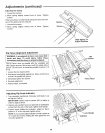
Using the Rip Fence
Ripping, bevel ripping, resawing and rabbeting are per-
formed using the rip fence together with the auxiliary
fence/work support, push stick or push block,
I WARNING: For your own safety, read and always
observe all safety precautions listed in manual and
on saw.
Additional Safety instructions for Rip Cuts
• Never use the miter gauge when ripping
• Use a push stick whenever lhe fence is 2 or more
inches from the blade,
• When thru-sawing, use an auxiliary fence and push
block whenever the fence must be between 1/2 and 2
inches from the blade
• Never thru-saw rip cuts narrower than t/2 inch,
oNever rip anything shorter than 10" long,.
• When using a push stick or push block, the trailing end
of the workpiece must be square A push stick or block
against an uneven end could slip off or push the work-
piece away from the fence,
o A featherboard can help guide the workpiece_ (See
"Basic Saw OperatiomUsing Featherboards for Thru-
Sawing" section,)
,Always use featherboards for any non thru-sawing rip
type cuts, (See "Basic Saw Operations-Using Feather-
boards for Non Thru-sawing" section)
Before Starting:
oTo avoid kickbacks and slips into the blade, make sure
the rip fence is parallel to the sawblade
• Before thru-sawing, check the anti-kickback pawls, the
pawls must stop a kickback once it has started,,
Replace or sharpen anti-kickback pawts when points
become dull
° Plastic and composition (like hardboard) materials may
be cut on your saw, However, since these are usually
quite hard and slippery, the anti-kickback pawls may
not stop a kickback, Therefore, be especially careful in
your setup and cutting procedures,
While Thru-sawing:
oTo avoid kickbacks and slips into the blade, always
push forward on the section of the workpiece between
the sawblade and the rip fence Never push forward on
the piece being cut off
Ripping
Definition: Cutting operation along the length of the work-
piece,
Position the fence to the desired width of rip and lock in
place,
Before starting to rip, be sure:
1 Rip fence is parallel to sawblade
2 Spreader is properly aligned with sawblade
3 Anti-kickback pawls are functioning properly,
When ripping long boards or large panels, always use a
work support A simple support can be made by clamping
a piece of plywood to a sawhorse
WARNING: To avoid kickback, push forward only ]
on the part of the workpiece that will pass between
1the blade and the fence.
Keep your hands out of the blade path,
Feed the workpiece by pushing forward only on the part
of the workpiece that will pass between the blade and the
fence
Stop your left thumb at the front edge of the table Finish
the cut with the appropriate pusher
Always Support Long
Or Wide Workpieces
31


















